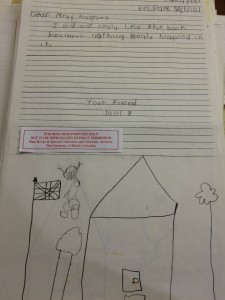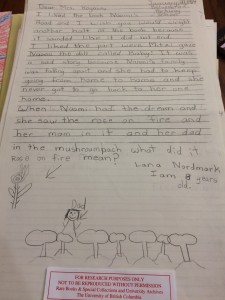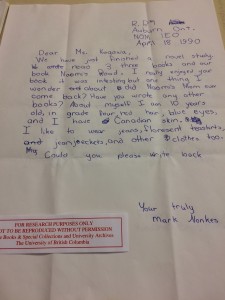Hello Readers,
Recently in my ASTU class we have been discussing the book Obasan by Joy Kogawa. In this novel Kogawa tells the story of a Canadian family of Japanese descent and their experience of the relocation and internment of people of Japanese descent living on the West Coast during World War II. We also had the opportunity to visit the fonds of Joy Kogawa, which she generously donated to UBC many years ago. We were able to examine letters of rejection from publishers, fan mail, notes and historical documents regarding her novels, and letters from the Prime Minister, among other documents relating to the creation and history of Kogawa’s novels. While some documents appeared more important than others (especially the letter from the Prime Minister regarding his desire to read the novel), I was particularly interested with the letters written by elementary students to Kogawa regarding her children’s book Naomi’s Road.
The Japanese internment and relocation is a particularly difficult topic to discuss among adults, yet alone children. While there were a few letters that spoke of her book as boring or just gave frivolous information (ex: birthday, mother’s name, etc.), there were a few letters that were notably analytical of the book. One letter in particular asks Kogawa to explain the symbol of the mushroom in her book (not included in Obasan). It is interesting that even at such a young age kids are picking up on literary symbols and themes.
Other children inquired about Naomi’s mother, what happened to her? There are some questions that are better left unanswered, as they are too difficult or heartbreaking to explain to children. The absence of closure in Kogawa’s children’s book reminded me of a reappearing saying in Obasan, “Kodomo no tame”. This roughly translates to “for the children”. Kogawa is similar to her characters Obasan and Aunt Emily, as she decides not to tell her reader’s about Stephen and Naomi mothers’ injuries and reasons for staying in Japan.
Overall the letters from the school kids were quite amusing. It is important to educate people at such a young age of the various traumas experienced in our country.
Please find below some of the letters found in the Kogawa fonds.
 One child sharing his opinion of the book.
One child sharing his opinion of the book.
 A letter containing literary analysis and further questions for discussion.
A letter containing literary analysis and further questions for discussion.
 One particularly amusing letter, one sentence reads “About myself, I am 10 years old in grade four, red hair, blue eyes, and I have Canadian skin”.
One particularly amusing letter, one sentence reads “About myself, I am 10 years old in grade four, red hair, blue eyes, and I have Canadian skin”.
Works Cited
Joel. Letter from Joel to Joy Kogawa. 21 Jan. 1989. Box 28 File 3. Joy Kogawa fonds.University of British Columbia Library Rare Books and Special Collections. Vancouver. Canada
Nonkes, Mark. Letter from Mark Nonkes to Joy Kogawa. 18 April 1990. Box 28 File 3.Joy Kogawa fonds. University of British Columbia Library Rare Books and Special Collections. Vancouver. Canada.
Nordmark, Lana. Letter from Lana Nordmark to Joy Kogawa. 21 Jan. 1989. Box 28 File. Joy Kogawa fonds. University of British Columbia Library Rare Books and Special Collections. Vancouver. Canada.